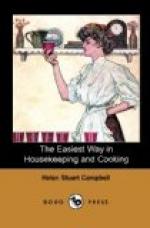This wheat is taken as bread, white or brown, biscuits, crackers, various preparations of the grain whether whole or crushed, and among the Italians as macaroni, the most condensed form of cereal food. The best macaroni is made from the red wheat grown along the Mediterranean Sea, a hot summer and warm climate producing a grain, rich, as already mentioned, in nitrogen, and with a smaller proportion of water than farther north. The intense though short summer of our own far North-west seems to bring somewhat the same result, but the outer husk is harder. This husk was for years considered a necessity in all really nutritious bread; and a generation of vegetarians taking their name from Dr. Graham, and known as Grahamites, conceived the idea of living upon the wheaten flour in which husk and kernel were ground together. Now, to stomachs and livers brought to great grief by persistent pie and doughnuts and some other New-England wickednesses, these husks did a certain office of stimulation, stirring up jaded digestions, and really seeming to arrest or modify long-standing dyspepsia. But they did not know what we do, that this outer husk is a layer of pure silica, one of the hardest of known minerals. Boil it six weeks, and it comes out unchanged. Boil it six years, or six centuries, and the result would be the same. You can not stew a grindstone or bring granite to porridge, and the wheat-husk is equally obstinate. So long as enthusiasts ate husk and kernel ground together, little harm was done. But when a more progressive soul declared that in bran alone the true nutriment lay, and a host of would-be healthier people proceeded to eat bran and preach bran, there came a time when eating and preaching both stopped, from sheer want of strength to go on. The enthusiasts were literally starving themselves to death—for starvation is by no means mere deprivation of food: on the contrary, a man may eat heartily to the day of his death, and feel no inconvenience, so far as any protest of the stomach is concerned, yet the verdict of the wise physician would be, “Died of starvation.” If the food was unsuitable, and could not be assimilated, this was inevitable. Blood, muscle, nerve—each must have its fitting food; and thus it is easy to see why knowledge is the first condition of healthful living. The moral is: Never rashly experiment in diet till sure what you are about, and, if you can not for yourselves find out the nature of your projected food, call upon some one who can.
Where wheat is ground whole, it includes six and a half parts of heat-producers to one of flesh-formers. The amount of starch varies greatly. Two processes of making flour are now in use,—one the old, or St. Louis process; the other, the “new process,” giving Haxall flour. In the former, grindstones were used, which often reached so great a degree of heat as to injure the flour; and repeated siftings gave the various grades. In the new, the outer husk is rejected, and a system of knives




